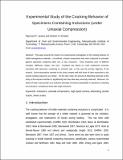Experimental study of the cracking behavior of specimens containing inclusions (under uniaxial compression)
Author(s)
Janeiro, Raymond P.; Einstein, Herbert H.
DownloadEinstein_7-22-09Janeiro.pdf (1.461Mb)
OPEN_ACCESS_POLICY
Open Access Policy
Creative Commons Attribution-Noncommercial-Share Alike
Terms of use
Metadata
Show full item recordAbstract
This paper presents the results of an experimental
investigation on the cracking behavior of
brittle heterogeneous materials. Unconfined, uniaxial
compression tests were conducted on prismatic gypsum
specimens containing either one, or two, inclusions.
These inclusions were of different strengths,
stiffnesses, shapes, and sizes. Emphasis was placed on
crack coalescence processes associated with specimens
containing an inclusion pair, as this was the primary
objective of the research. Some observations reported
in this study compare well with those of other researchers
as the overall cracking sequences are similar. On the
other hand, the amount of debonding observed in this
study at the inclusion interface is significantly less than
what was previously observed. Moreover, the extent of
shear crack growth at an inclusion boundary increased
substantially in specimens containing two inclusions,
compared to those with single inclusions.
Date issued
2010-02Department
Massachusetts Institute of Technology. Department of Civil and Environmental EngineeringJournal
International Journal of Fracture
Publisher
Springer
Citation
Janeiro, Raymond, and Herbert Einstein. “Experimental study of the cracking behavior of specimens containing inclusions (under uniaxial compression).” International Journal of Fracture 164.1 (2010): 83-102.
Version: Author's final manuscript
ISSN
0376-9429